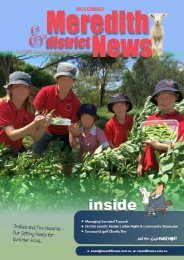Meredith News Feb 2021
You also want an ePaper? Increase the reach of your titles
YUMPU automatically turns print PDFs into web optimized ePapers that Google loves.
22 MEREDITH and DISTRICT NEWS
Gorse (Part 3 of 4)
Janene Schillier
Carrying Out the Program
Once you map out the areas requiring control,
develop a program based on the type of land or
infestation you need to treat and the options you
have available. Before following these programs, it
is important that you develop a five year gorse
control plan work out your primary control, and
follow up method prevent further seed spread.
Various situations can include steep or stony
pasture, arable pasture, native vegetation, riparian
zone, stream banks, creeks, water courses or near
dams)
Multiple Approaches - Large and smaller
infestations
Once you start your plan multiple methods can be
used.
For example significant infestations may be suitable
for mechanical control (excavators, blades etc)
followed by spraying with herbicide when it shoots.
Smaller areas might be done by spraying with
herbicide (effectively kills the plant & roots if done
correctly) and manual methods like cut and
applying herbicide to the cut surface. The method
should be decided before starting. Reading the Best
Practice Manual (available on the web) is
recommended because it discusses the successful
methods for every circumstance and saves time
working out best methods yourself (see Victorian
Gorse Taskforce) website. Whatever is decided the
investment to control gorse is wasted if follow up,
monitoring and enthusiasm for results are ignored.
Stopping the seed bank can be effective in smaller
areas with manual chopping with loppers to gain
access, making a pile and then in suitable weather
building a fire from other material such as branches,
to get the fire going then systematically burn the
lopped gorse. Note : this method is not available in
the summer or warmer months. Gorse is highly
inflammable and poses a significant risk. Gorse
seed is destroyed if heated to a hundred degrees for
20 minutes - including seeds which are on the top
few centimetres of soil (if this where the heat is)
Inspect for new growth and apply spray. Heat
stimulates seed germination and growth of multiple
stalks - a big problem if not sprayed.
Gorse will return if there is no follow up, so plan to
implement your methods for 5 years at least.
Planting vegetation as a competitor is not
recommended until certainty of containment.
Examples of planting too early has resulted in
multiple problems of gorse return in amongst the
new vegetation.
Thought for a yearly budget over a period of 5 years
or more, combined with researching techniques and
sticking to a vigilant approach will give positive
results, satisfaction and encouragement.
Landholders can do a lot themselves thus reducing
costs. Some may engage a contractor. A hands on
approach allows you to be educated, monitor and see
results over time
In summary methods are
• Cut and apply herbicide to the cut surface
(within 20 seconds).
• Herbicide spray and monitor, repeat and check
at least annually.
• Use of excavator to remove plants then
herbicide spray follow up.
• Doing this yourself or hiring an experienced
contractor.
Young seedlings are easy to pull out by the roots in
damp soil. This is a good winter job. Gorse is a
difficult invasive woody weed, but with a vigilant
approach, great results can be achieved. Seek
assistance from the Victorian Gorse Taskforce and
other websites (Tasmania)
Part four next month Results, Resources and Future
Management will conclude these articles on Gorse.
















